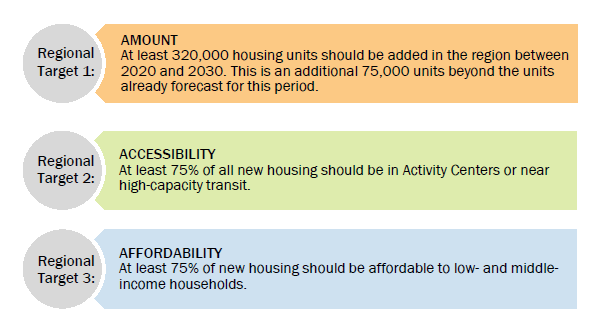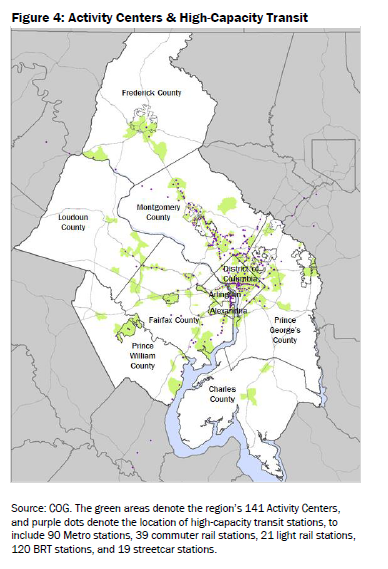Three regional housing targets recently adopted by officials at COG work in tandem with the TPB’s Aspirational Initiatives, particularly with the “bring jobs and housing closer together” initiative.
When the TPB’s Long-Range Plan Task force studied numerous ideas in 2017 to help the region accomplish its transportation goals, the analysis revealed that providing additional housing closer to job centers and multimodal travel choices would go a long way to reduce congestion and make the transportation system work better.
Currently, there’s a housing shortage in the region that is expected to worsen without intervention. Because of this, more than 325,000 workers commute from areas outside the region into metropolitan Washington each day for work. These current commuting patterns, perhaps partly driven by an inadequate amount of affordable housing options available, require people to travel long distances for jobs, contributing significantly to the region’s traffic congestion.
According to the Task Force’s analysis, a regional jobs to housing ratio of 1.54 provides a more optimal balance of jobs and housing; the current ratio is 1.64 jobs per household, which explains in part why many workers commute from outside the region.
To strike this better balance, COG staff used that Task Force ratio to estimate that the region needs 75,000 additional households beyond what is currently forecast for this region by 2030, a total of 320,000 new units.
COG’s Housing Initiative
In September 2018, the COG Board directed the organization’s planning staff, as well as housing and planning directors from across the region to determine whether more housing could be added, where it should be located, and how much it should cost to meet resident needs.
A more coordinated focus on housing would not only help to optimize economic competitiveness, but it would also improve transportation system performance, not to mention quality of life.
One year later, in September of this year, officials reached consensus on three regional targets.

In addition to the Amount or production target, the Accessibility target is also linked to the TPB’s work.
The idea of concentrating growth in Activity Centers, places primed for growth where residents can live, work, and play, has been endorsed, promoted, and implemented by the area’s leaders in places throughout the region for almost 20 years. The TPB prioritizes this concept of strong, dynamic Activity Centers throughout its planning activities. The region has made significant progress centering growth in Activity Centers, even exceeding its goal called for in Region Forward.
As part of its Visualize 2045 long-range transportation plan in 2018, the TPB also identified a regional network of 297 high-capacity transit stations, including many outside of Activity Centers, that could be potential locations for additional growth.
 The housing targets call for an even more ambitious goal of locating 75 percent of additional new housing in Activity Centers and near high capacity transit by 2030.
The housing targets call for an even more ambitious goal of locating 75 percent of additional new housing in Activity Centers and near high capacity transit by 2030.
The TPB’s analysis shows many benefits of implementing its initiative of bringing housing and jobs closer together, including a nearly 20% decrease in the congestion conditions planners otherwise anticipate in the future.
WHAT’S NEXT
In a presentation to the TPB in October, COG Executive Director Chuck Bean said the regional housing targets, like the Visualize 2045 Aspirational Initiatives, are not meant to “sit on a shelf.”
It will take an “all-hands on deck” approach to achieve the region’s housing and transportation goals, with collaboration across sectors and across jurisdictions. It will also require coordination across all areas of planning.
For example, harnessing opportunities to build additional housing of varying types on underdeveloped land around some of Metro’s stations, as well as along new transit lines like Metro’s Silver Line in Virginia and the Purple Line in Maryland, supports these shared goals to meet future housing needs while minimizing further strains on the transportation system from in-commuting. Cumulatively, these policies contribute to the region’s progress toward its shared housing production goals.
TPB staff already have been working to make the seven Aspirational Initiatives—including bringing jobs and housing closer together—a reality. Staff are in the process of meeting with member jurisdictions’ transportation and land-use staff to learn how these concepts can become projects, programs, and policies and how the TPB can help. Staff are also studying the areas around Metro Stations to identify opportunities for making them more accessible by foot or bike.
A focus on creating transit-oriented communities will be “our future from both a transportation and land use perspective,” said Bean.
Learn more about Visualize 2045 Aspirational Initiatives.
Learn more about the COG Housing Targets.